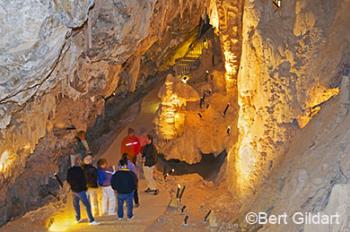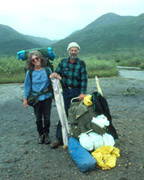Photographing Mitchell Caverns

Mitchell Caverns
©Bert Gildart: Photographing caverns can present an immense lighting challenge, and Mitchell Cavern, a California state park literally engulfed on all sides by the Mojave National Preserve, is no exception.
The problem is even more acute if you are trying to include people in your scene, and the only way I’ve found that works somewhat successfully is to place your camera on a tripod, attach a cable release and then set your camera to “Slow Sync,” available on my Nikon D-300 and on most advanced digital cameras. Light from the flash will be adequate to illuminate visitors, but not the huge cavern. You’ll then need a long exposure to properly record all those stalagmites and stalactites illuminated only by the low lighting provided by the caverns.
PHOTOGRAPIC SPECIFICS
Here, then, is the way the camera functioned in response to those settings. In my case, proper exposure for the cavern illuminated with fixed cavern lights was F-5.6 at about five seconds. First, then, the camera used F-5.6 and the quick high-speed blink of the strobe as the proper exposure for people–and then left the aperture open. Then, because of the slow sync setting the camera remained open for five more seconds and used the cavern lights for the rest of the exposure. The result is the image shown here.
Tour guide for today’s outing was a delightful speaker named Myke Ray. Because weather was not ideal, he prefaced his talk from a sheltered area explaining the importance of tiny calcium-producing micro-organisms that provided the foundations for the cave millions of years ago. Tectonic plate activity subsequently took the layers upon layers of calcium and thrust it into the right position for subsequent cave formation. Ground water did much of the rest.
The result today is a series of spectacular caverns with individual formations that Myke helped embed into our memories with names familiar to us all. “See South America?” he said. Or, “see the giant rooster?”
He was referring, of course, to the orientation of the various stalagmites and stalactites and what, with imagination, you might easily envision–and then easily recall in the future.
SNOWY DESERT DAY
The tour took about 1-1/2 hours. Temperature inside the cavern registered 65 degrees and it was a measurement on everyone’s mind. Outside, the Mojave Desert which typically averages about 70 at this time of year, was asserting her temperamental side and had taken a drastic turn downward.

Snow engulfs Hole in the Wall VC
Today, Palm Sunday, outdoor temperatures in and around the preserve registered about 32. Snow was falling and the wind of several days ago had not yet abated, so it was a good day for spelunking.
However, these outrageous weather conditions must come to a halt, and after complaining to the weatherman, have learned he will accommodate us visiting Montanans and that by mid-week temperatures will be back in the low 80s.
That, Sir, will be more like it–and we thank you for your cooperation.
(Alert: Here’s a posting from ABOUT one year ago.)

